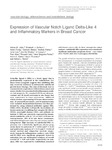Expression of vascular notch ligand delta-like 4 and inflammatory markers in breast cancer.
| dc.contributor.author | Jubb, AM | en |
| dc.contributor.author | Soilleux, EJ | en |
| dc.contributor.author | Turley, H | en |
| dc.contributor.author | Steers, G | en |
| dc.contributor.author | Parker, A | en |
| dc.contributor.author | Low, I | en |
| dc.contributor.author | Blades, J | en |
| dc.contributor.author | Li, J-L | en |
| dc.contributor.author | Allen, P | en |
| dc.contributor.author | Leek, R | en |
| dc.contributor.author | Noguera-Troise, I | en |
| dc.contributor.author | Gatter, KC | en |
| dc.contributor.author | Thurston, G | en |
| dc.contributor.author | Harris, AL | en |
| dc.date.accessioned | 2017-11-27T16:49:01Z | |
| dc.date.available | 2017-11-27T16:49:01Z | |
| dc.date.issued | 2010-04 | en |
| dc.identifier.uri | http://hdl.handle.net/10026.1/10313 | |
| dc.description.abstract |
Delta-like ligand 4 (Dll4) is a Notch ligand that is predominantly expressed in the endothelium. Evidence from xenografts suggests that inhibiting Dll4 may overcome resistance to antivascular endothelial growth factor therapy. The aims of this study were to characterize the expression of Dll4 in breast cancer and assess whether it is associated with inflammatory markers and prognosis. We examined 296 breast adenocarcinomas and 38 ductal carcinoma in situ tissues that were represented in tissue microarrays. Additional whole sections representing 10 breast adenocarcinomas, 10 normal breast tissues, and 16 angiosarcomas were included. Immunohistochemistry was then performed by using validated antibodies against Dll4, CD68, CD14, Dendritic Cell-Specific Intercellular adhesion molecule-3-Grabbing Non-integrin (DC-SIGN), CD123, neutrophil elastase, CD31, and carbonic anhydrase 9. Dll4 was selectively expressed by intratumoral endothelial cells in 73% to 100% of breast adenocarcinomas, 18% of in situ ductal carcinomas, and all lactating breast cases, but not normal nonlactating breast. High intensity of endothelial Dll4 expression was a statistically significant adverse prognostic factor in univariate (P = 0.002 and P = 0.01) and multivariate analyses (P = 0.03 and P = 0.04) of overall survival and relapse-free survival, respectively. Among the inflammatory markers, only CD68 and DC-SIGN were significant prognostic factors in univariate (but not multivariate) analyses of overall survival (P = 0.01 and 0.002, respectively). In summary, Dll4 was expressed by endothelium associated with breast cancer cells. In these retrospective subset analyses, endothelial Dll4 expression was a statistically significant multivariate prognostic factor. | en |
| dc.format.extent | 2019 - 2028 | en |
| dc.language | eng | en |
| dc.language.iso | eng | en |
| dc.subject | Adaptor Proteins, Signal Transducing | en |
| dc.subject | Aged | en |
| dc.subject | Breast | en |
| dc.subject | Breast Neoplasms | en |
| dc.subject | Calcium-Binding Proteins | en |
| dc.subject | Cell Line, Tumor | en |
| dc.subject | Disease-Free Survival | en |
| dc.subject | Endothelium | en |
| dc.subject | Female | en |
| dc.subject | Hemangiosarcoma | en |
| dc.subject | Humans | en |
| dc.subject | Immunohistochemistry | en |
| dc.subject | In Situ Hybridization | en |
| dc.subject | Inflammation | en |
| dc.subject | Intercellular Signaling Peptides and Proteins | en |
| dc.subject | Middle Aged | en |
| dc.subject | Prognosis | en |
| dc.title | Expression of vascular notch ligand delta-like 4 and inflammatory markers in breast cancer. | en |
| dc.type | Journal Article | |
| plymouth.author-url | https://www.ncbi.nlm.nih.gov/pubmed/20167860 | en |
| plymouth.issue | 4 | en |
| plymouth.volume | 176 | en |
| plymouth.publication-status | Published | en |
| plymouth.journal | Am J Pathol | en |
| dc.identifier.doi | 10.2353/ajpath.2010.090908 | en |
| plymouth.organisational-group | /Plymouth | |
| plymouth.organisational-group | /Plymouth/REF 2021 Researchers by UoA | |
| plymouth.organisational-group | /Plymouth/REF 2021 Researchers by UoA/UoA01 Clinical Medicine | |
| plymouth.organisational-group | /Plymouth/REF 2021 Researchers by UoA/UoA01 Clinical Medicine/UoA01 Clinical Medicine | |
| dc.publisher.place | United States | en |
| dc.identifier.eissn | 1525-2191 | en |
| dc.rights.embargoperiod | Not known | en |
| rioxxterms.versionofrecord | 10.2353/ajpath.2010.090908 | en |
| rioxxterms.licenseref.uri | http://www.rioxx.net/licenses/all-rights-reserved | en |
| rioxxterms.type | Journal Article/Review | en |


